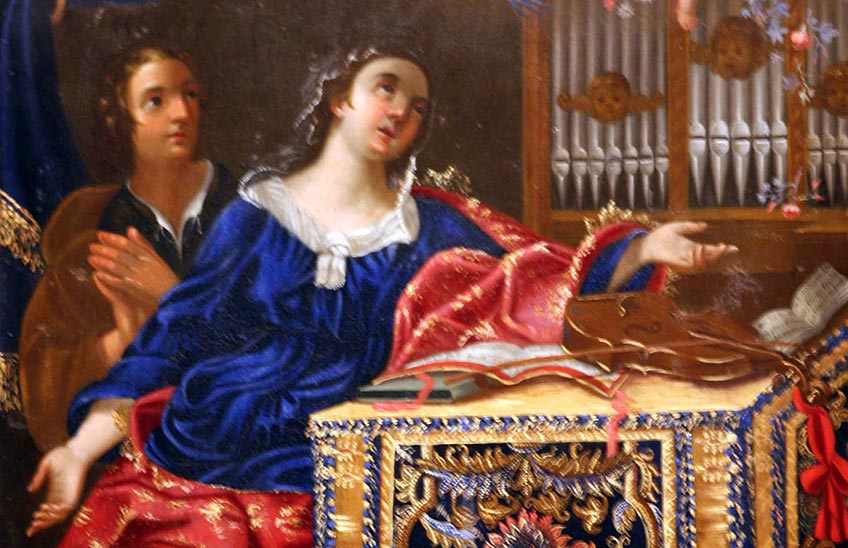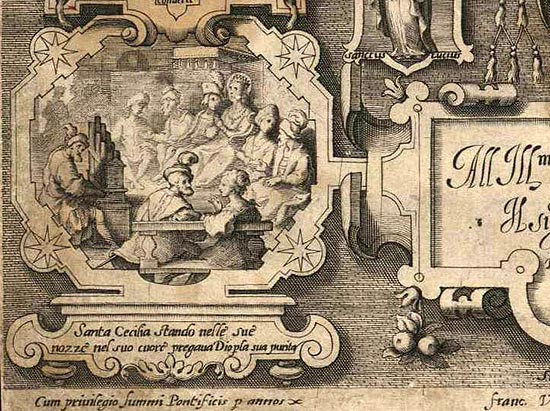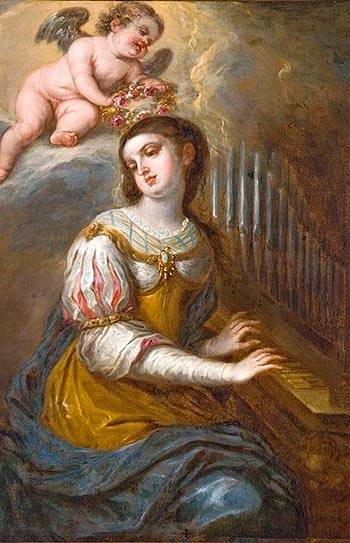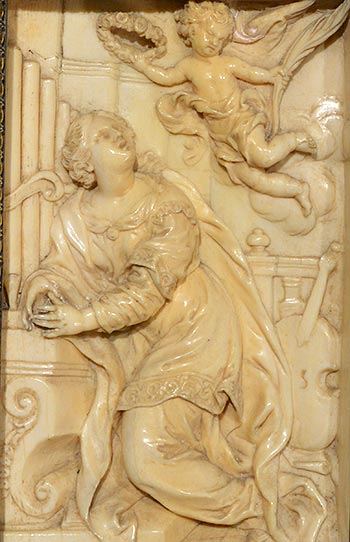Saint Cecilia, Roman martyr and her late sponsorship on music

PhotoI. Miguéliz/Detail of a Baroque painting of Saint Cecilia in the sacristy of Pamplona Cathedral.
More than twelve centuries after the death of the Roman martyr, Saint Cecilia was declared patron saint of music by Pope Gregory XIII in 1594. From then on, her figure, already venerated as an advocate for musicians, became universally revered. Her feast day, 22 November, which corresponds to the day of her birth, has been adopted worldwide for the celebration of Music Day.
Since the 17th century, several European countries have celebrated their feast day with musical festivals. In 1683, the Musical Society of London established the annual St. Cecilia's Day festivals, in which the greatest British composers and poets have participated. Henry Purcell did it with his well-known ode Laudate Ceciliam in that year. Musicians, painters and poets such as Raphael, Poussin, Dryden, Pope, Purcell, etc., celebrated it with their works. The Cecilianist movement of the 19th century took her as a special advocate for the reform of liturgical music, which culminated in the Motu Proprio of St. Pius X in 1903.
|
|
|
In recent times, board of trustees has not been at its best. A couple of examples serve as sample . On the one hand, the American magazine Caecilia, after 92 years of publication, changed its name to Sacred Music, and on the other, the Pamplona-based Orquesta de Santa Cecilia, created in 1879, was renamed Orquesta Pablo Sarasate (now Orquesta Sinfónica de Navarra) in 1993.
The young Cecilia, martyred around the year 230, had reached board of trustees on music, largely because of a faulty version of what was contained in the conference proceedings The manuscripts that recorded her martyrdom date from the 5th century, and are therefore more than three centuries after her death. The account has little historical value and is rather a pious romance, like so many others compiled in the 5th and 6th centuries.
In discussing her marriage to Valerius, whom she converted to Christianity, it is stated: "Venit díes in quo thalamus collacatus est, et, cantantibus organis, illa [Cecilia virgo] in corde suo soli Domino decantabat [dicens]: Fiat Domine cor meum et corpus meus inmaculatum et non confundar" ("The day came when the marriage was celebrated, and, while the musical instruments were playing, she [the virgin Cecilia] in her heart to her only Lord sang [saying]: [Lord] make my heart and my body immaculate and do not confuse"). The Latin word organis (musical instruments) was translated as organ and this instrument would accompany many of its representations from late medieval times onwards.
Actually, the oldest codices did not say "cantantibus" or "canentibus", but "candentibus organis". Therefore, the reference letter would be the instruments of torture, and the antiphon would describe Cecilia, "among the burning tools, she sang to her only Lord in her heart". The antiphon would not refer so much to the wedding feast, but rather to the moment of martyrdom.
At final, an erroneous transcription and translation of the Latin would have led to the universal patronage of music. Something similar in relation to Latin translations occurred in the case of the prophet Elijah, represented with two horns on his forehead, the origin of which lies in the Vulgate, in which the luminous rays are compared to horns: "Videbant faciem Moysi esse cornutam". A faulty version of this text caused him to be represented with horns, which were supposed to be present as a symbol of power and strength, a legacy of the Canaanite gods.
The images of Saint Cecilia show her, full of joy for the presence of the Lord, playing musical instruments such as the lyre, the zither, the organ, the harpsichord, the harp, the violin, the violoncello, and surrounded by angels singing and personifying the spirit of song and sacred music and, at final, of beauty, truth and good that converge together and lead men to meet God. Examples of great artists who have depicted it include Raphael, Poussin, Domenichino, Guido Reni, Rubens, Pierre Mignard and Francisco Salzillo.

Marriage of Saint Cecilia in a vignette of the wundervita by Cornelio Galle by drawing by Francesco Vanni in 1601. Photo Library Services Digital Hispanica. Library Services National


